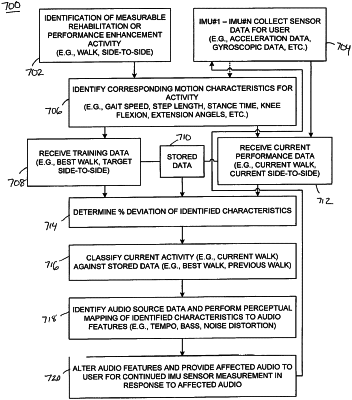| CPC A61B 5/7415 (2013.01) [A61B 5/11 (2013.01); A61B 5/1118 (2013.01); A61B 5/112 (2013.01); A61B 5/1124 (2013.01); A61B 5/486 (2013.01); G06N 3/02 (2013.01); G06N 20/00 (2019.01); G10H 1/0091 (2013.01); G16H 20/30 (2018.01); G16H 40/67 (2018.01); G16H 50/20 (2018.01); H04N 19/10 (2014.11); A61B 5/6828 (2013.01); A61B 2505/09 (2013.01); G10H 2210/221 (2013.01); G10H 2210/311 (2013.01); G10H 2220/201 (2013.01); G10H 2220/321 (2013.01); G10H 2220/391 (2013.01); G10H 2220/395 (2013.01); G10L 21/003 (2013.01)] | 32 Claims |

|
1. A system to modify an audio signal in response to changes in motion patterns of a wearer of a leg prosthesis, the system comprising:
the leg prosthesis comprising a socket portion and a lower portion connected by a knee joint, the leg prosthesis further comprising at least one sensor;
a memory associating a plurality of performance activities with a plurality of motion characteristics and a plurality of controllable audio features, wherein a particular performance activity of the plurality of performance activities is associated with a particular set of motion characteristics of the plurality of motion characteristics and a particular set of controllable audio features of the plurality of controllable audio features; and
one or more processors configured to:
receive the audio signal from a source, wherein the source stores the audio signal,
identify a performance of a performance activity for assessment,
consult the memory to identify a first set of motion characteristics and a first set of controllable audio features associated with the performance of the performance activity,
receive sensor motion data from the at least one sensor,
determine a plurality of measurements for the first set of motion characteristics based on the sensor motion data;
determine a deviation value and deviation type based on differences between the plurality of measurements and a corresponding plurality of user-specific target measurements, wherein the corresponding plurality of user-specific target measurements are generated based at least in part on measurements associated with a prior performance of the performance activity by the wearer;
based at least in part on a determination that the deviation value is greater than a first deviation threshold and less than a second deviation threshold, modify the received audio signal by adjusting at least one controllable audio feature of the first set of controllable audio features by a first amount, wherein the at least one controllable audio feature is based at least in part on the deviation type; and
based at least in part on a determination that deviation value is greater than the second deviation threshold, modify the received audio signal by adjusting the at least one controllable audio feature of the first set of controllable audio features by a second amount, and wherein the second deviation threshold is greater than the first deviation threshold the second amount is greater than the first amount.
|